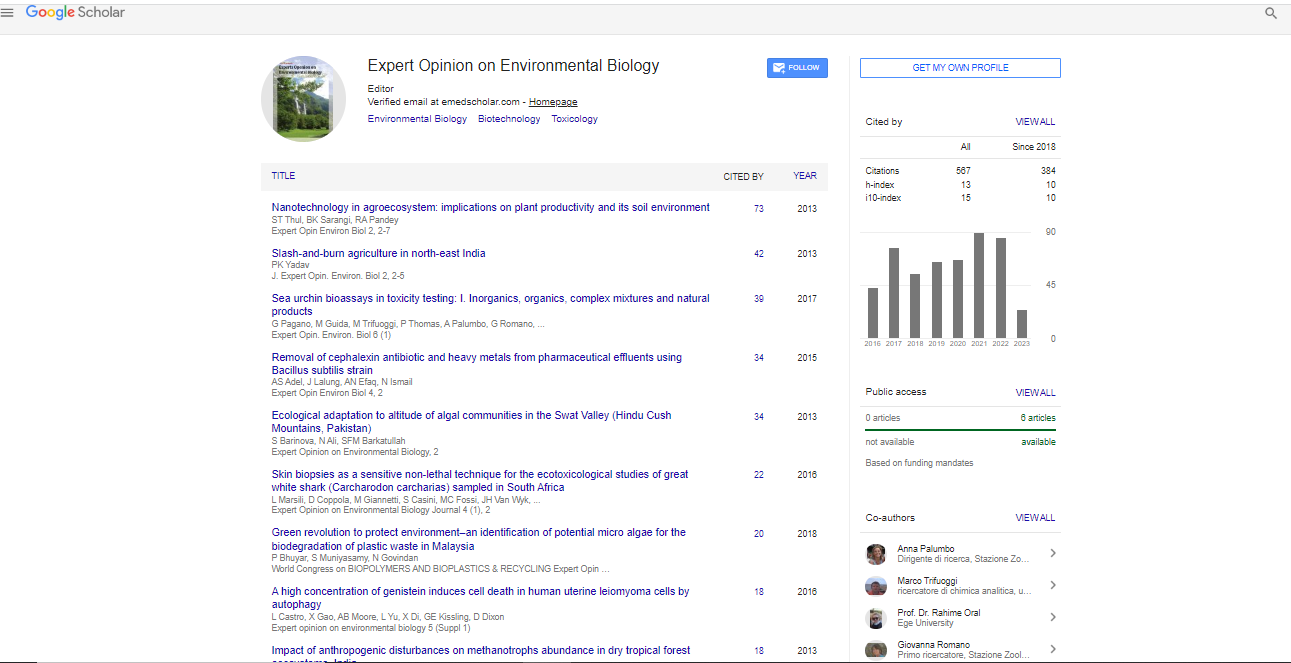Rapid Communication, Expert Opin Environ Biol Vol: 14 Issue: 1
Impacts of Climate Change on Marine Biodiversity: Challenges and Conservation Strategies
Graciela Husser*
Department of Biotechnology, Hanoi National University of Education, Vietnam
- *Corresponding Author:
- Graciela Husser
Department of Biotechnology, Hanoi National University of Education, Vietnam
E-mail: gracielahuss@hnu.vn
Received: 01-Mar-2025, Manuscript No. EOEB-25-169978, Editor assigned: 03-Mar-2025, PreQC No. EOEB-25-169978(PQ), Reviewed: 17-Mar-2025, QC No. EOEB-25-169978, Revised: 21-Mar-2025, Manuscript No. EOEB-25-169978(R), Published: 28-Mar-2025, DOI: 10.4172/ 2325-9655.1000239
Citation: Graciela H (2025) Advancing Cardiac Healing: The Role of Stem Cells in Regeneration and Future Prospects. J Regen Med 14:1.
Copyright: © 2025 Graciela H. This is an open-access article distributed under the terms of the Creative Commons Attribution License, which permits unrestricted use, distribution and reproduction in any medium, provided the original author and source are credited.
Abstract
Climate change is one of the most significant threats to marine
biodiversity, causing shifts in species distribution, habitat loss, and
altered ecosystem functioning. Rising sea surface temperatures,
ocean acidification, and deoxygenation are driving unprecedented
changes in marine environments. This article examines the key
impacts of climate change on marine biodiversity, focusing on
coral reefs, fisheries, and marine mammals. It further discusses
conservation strategies such as marine protected areas (MPAs),
habitat restoration, and climate-resilient fisheries management to
mitigate biodiversity loss and maintain ecosystem services.
Keywords: Climate change; Marine biodiversity; Ocean acidification; Coral reefs; Conservation strategies
Keywords
Climate change; Marine biodiversity; Ocean acidification; Coral reefs; Conservation strategies
Introduction
Marine ecosystems are critical for global biodiversity, supporting millions of species and providing vital services, including food, climate regulation, and livelihoods. However, climate change has emerged as a major driver of biodiversity loss in the oceans. Key stressors such as increased sea temperatures, rising sea levels, ocean acidification, and reduced oxygen levels are altering marine habitats and species distributions. Understanding the extent of these impacts is essential for developing strategies to protect and restore marine biodiversity [1].
Description
Climate change has far-reaching implications for marine biodiversity:
- Rising sea temperatures: Elevated ocean temperatures cause coral bleaching, disrupt fish migration patterns, and alter breeding cycles in many marine organisms. Coral reefs, home to nearly a quarter of all marine species, are particularly vulnerable.
- Ocean acidification: Increased carbon dioxide (COâ??) absorption by oceans reduces pH levels, impairing the ability of calcifying organisms, such as corals, mollusks, and certain plankton, to build their skeletons and shells [2].
- Sea level rise: Coastal habitats, including mangroves, salt marshes, and seagrass meadows, are being submerged or eroded, leading to habitat loss for species that depend on these areas for breeding and feeding.
- Deoxygenation: Warming waters hold less oxygen, creating hypoxic zones that can lead to massive marine die-offs and reduced biodiversity.
- Food web disruption: Changes in plankton communities affect the entire marine food chain, from small fish to apex predators, influencing productivity and resilience [3].
Results
Studies indicate that approximately 60% of coral reefs worldwide are under threat due to climate change and related stressors. Ocean acidification is projected to increase by 100â??150% by the end of the 21st century, significantly affecting marine calcifiers. Climate-induced shifts in fish distribution have already impacted global fisheries, with tropical nations experiencing reduced catches. The Arctic, warming at twice the global average, has seen a notable decline in ice-dependent species such as polar bears and walruses [4].
Discussion
Climate change affects marine biodiversity at multiple levels, from genes to ecosystems. Mitigation strategies must address both global and local drivers of change. The establishment of Marine Protected Areas (MPAs) has shown promise in enhancing resilience by reducing additional human pressures such as overfishing and habitat destruction. Restoration projects, such as coral gardening and mangrove planting, are effective in rehabilitating degraded habitats. Furthermore, adopting climate-resilient fisheries management can ensure sustainable harvests in changing conditions. Collaboration between nations is essential, given the transboundary nature of marine ecosystems. Integrating climate change considerations into marine policy frameworks can strengthen conservation outcomes. Public awareness campaigns and citizen science initiatives can also contribute to monitoring and protecting marine biodiversity [5].
Conclusion
Climate change poses a severe threat to marine biodiversity, necessitating urgent global action. Mitigation measures must focus on reducing greenhouse gas emissions, protecting vulnerable habitats, and promoting adaptive management strategies. With comprehensive conservation efforts, it is possible to enhance the resilience of marine ecosystems and safeguard the biodiversity that sustains human well-being.
References
- Cascino GD (1994) Epilepsy: contemporary perspectives on evaluation and treatment. Mayo Clinic Proc 69: 1199-1211.
- Castrioto A, Lozano AM, Poon YY, Lang AE, Fallis M, et al. (2011) Ten-Year outcome of subthalamic stimulation in Parkinson disease: a Blinded evaluation. Arch Neurol 68: 1550-1556.
- Chang BS, Lowenstein DH (2003) Epilepsy. N Engl J Med 349: 1257-1266.
- Cif L, Biolsi B, Gavarini S, Saux A, Robles SG, et al. (2007) Antero-ventral internal pallidum stimulation improves behavioral disorders in Lesch-Nyhan disease. Mov Disord 22: 2126-2129.
- De Lau LM, Breteler MM (2006) Epidemiology of Parkinson's disease. Lancet Neurol 5: 525-35.
 Spanish
Spanish  Chinese
Chinese  Russian
Russian  German
German  French
French  Japanese
Japanese  Portuguese
Portuguese  Hindi
Hindi 
